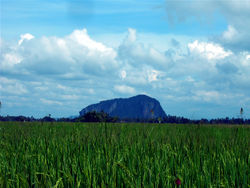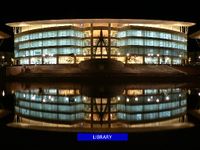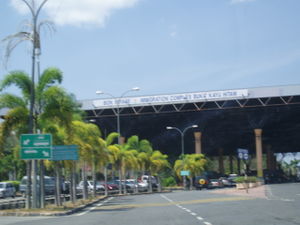Kedah
| Kedah قدح |
|||
|---|---|---|---|
| — State — | |||
| Kedah Darul Aman | |||
|
|||
| Anthem: Allah Selamatkan Sultan Mahkota (English:"God Save the Crowned Sultan") |
|||
|
|
|||
| Coordinates: | |||
| Capital | Alor Setar | ||
| Royal capital | Alor Setar | ||
| Government | |||
| - Ruling party | Pakatan Rakyat | ||
| - Sultan | Sultan Abdul Halim Muadzam Shah | ||
| - Menteri Besar (Chief Minister) | Dato' Ustaz Azizan Abdul Razak | ||
| Area | |||
| - Total | 9,426 km2 (3,639.4 sq mi) | ||
| Population (2009 est.) | |||
| - Total | 2,000,000 | ||
| - Density | 212.1/km2 (549.3/sq mi) | ||
| Human Development Index | |||
| - HDI (2003) | 0.741 (medium) | ||
| Postal code | 02xxx 05xxx to 09xxx |
||
| Calling code | 04 | ||
| Vehicle registration | K (Mainland Kedah) KV (Langkawi Island) |
||
| British control | 1909 | ||
| Japanese occupation | 1942 | ||
| Accession into Federation of Malaya | 1948 | ||
| Website | http://www.kedah.gov.my | ||
Kedah (Jawi: قدح, also known by its Arabic honorific, Darul Aman, or "Abode of Peace") is a state of Malaysia, located in the northwestern part of Peninsular Malaysia. The state covers a total area of over 9,000 km², and it consists of the mainland and Langkawi. The mainland has a relatively flat terrain, which is used to grow rice. Langkawi is an archipelago of islands, most of which are uninhabited. Kedah was called Syburi (Thai: ไทรบุรี) by the Siamese when it was under their influence.
Kedah borders the state of Perlis and shares an international boundary with the Songkhla and Yala provinces of Thailand to the north. It also borders the state of Perak to the south and Penang to the southwest.
The state's capital and royal seat is Alor Setar. Other major towns include Sungai Petani, and Kulim on the mainland, and Kuah on Langkawi.
Contents |
History
The Bujang Valley has remains of a Hindu-Buddhist kingdom that dates back to the 4th century AD, making it the oldest civilization of Peninsular Malaysia. The current royal family can trace their ancestry from this time. According to Hikayat Merong Mahawangsa or the Kedah Annals, Kedah was founded by a Hindu king named Merong Mahawangsa. According to the text further, the Sultanate of Kedah started in year 1136 when the 9th King Phra Ong Mahawangsa converted to Islam and adopted the name Sultan Mudzafar Shah.
In the 7th and 8th centuries, Kedah was under the domination of Srivijaya, and was later under Siam, until it was conquered by the Malay sultanate of Melaka in the 15th century. In the 17th century, Kedah was attacked by the Portuguese after their conquest of Melaka, and by Aceh. In the hope that Great Britain would protect what remained of Kedah from Siam, the sultan handed over Penang and then Province Wellesley to the British at the end of the 18th century. The Siamese nevertheless conquered Kedah in 1811, and it remained under Siamese control until transferred to the British by the Anglo-Siamese Treaty of 1909.
In World War II, Kedah (along with Kelantan) was the first part of Malaya to be invaded by Japan. The Japanese returned Kedah to their Thai allies who had it renamed Syburi, but it returned to British rule after the end of the war. Kedah was a reluctant addition to the Federation of Malaya in 1948.
Since 1958, the hereditary Sultan of Kedah has been Tuanku Abdul Halim Muadzam Shah. The Kedah Sultanate began when the 9th Kedah Maharaja Derbar Raja AD) converted to Islam and changed his name to Sultan Muzaffar Shah. Since then there have been 27 Sultans who ruled Kedah. The Menteri Besar (Chief Minister) is currently Datuk Seri Azizan Abdul Razak of (Pakatan Rakyat-PAS)
Geography

Kedah is the 8th largest state by land area and 8th most populated state in Malaysia, with a total land area and population of 9,426 km2 and 1,818,188 respectively.
The Pedu Lake is the largest man-made lake in the state.
Demographics
Kedah has a relatively heterogeneous populace constituted by the three major ethnic groups; the Malays, Chinese and Indians, similar to most of the other Malaysian states.
There are 1,336,352 Malays (who make up about 75.5% of the state's population), 252,987 Chinese (or 14.2%), 122,911 Indians (or 6.9%), 35,293 non-citizens (or 1.9%) and 27,532 people from other ethnic groups (or 1.5%) in the state. }
Government and politics
Constitution
Kedah's Constitution was promulgated by its Ruler in July 1950 and its full title in English is;
- The Laws of the Constitution of Kedah.
The various provisions laid down in the Constitution include the role and powers of the Monarch, the State Parliament and the State's Civil Service.
The Sultan of Kedah
The Sultan of Kedah is the constitutional ruler of the State. His position is hereditary and he holds office for life. The Ruler is the head of the religion of Islam in the State and the executive power of the state government is vested in him. The current Sultan is Sultan Abdul Halim of Kedah, who has reigned since 1958.
State Executive Council
The State Executive Council, which along with the Sultan is Kedah's executive branch of government. It is composed of the Menteri Besar, who is its chairman and Kedah's head of government, and ten other members. The Menteri Besar and other members of the council are appointed by the Sultan of Kedah from members of the Dewan Undangan Negeri (State Assembly). The current Menteri Besar is Dato' Seri Azizan Abdul Razak, of the Pan-Malaysian Islamic Party (also referred to as Parti Islam Se-Malaysia or PAS).
List of Chief Ministers
| Incumbent | Tenure | Political Affiliation |
|---|---|---|
| Mohamad Sheriff bin Osman | 1948–1954 | UMNO of Barisan Nasional |
| Tunku Ismail bin Tunku Yahaya | 1954–1959 | UMNO of Barisan Nasional |
| Syed Omar bin Syed Abdullah Shahabuddin | 1959–1967 | UMNO of Barisan Nasional |
| Tun Dato' Seri Utama Syed Ahmad bin Syed Mahmud Shahabuddin | 1967–1978 | UMNO of Barisan Nasional |
| Syed Nahad bin Tun Syed Sheh Shahabuddin | 1978–1985 | UMNO of Barisan Nasional |
| Haji Osman bin Haji Aroff | 1985–1996 | UMNO of Barisan Nasional |
| Sanusi bin Junid | 1996–1999 | UMNO of Barisan Nasional |
| Syed Razak bin Syed Zain Barakhbah | 1999–2005 | UMNO of Barisan Nasional |
| Dato' Haji Mahdzir bin Khalid | 2005–2008 | UMNO of Barisan Nasional |
| Dato' Seri Ustaz Haji Azizan bin Abdul Razak | 2008–present | PAS of Pakatan Rakyat |
Kedah State Assembly
- See Also:Breakdown of State Seats Representatives elected 2008
The state also has a legislative branch, called the State assembly. It is similar to the Parliament but is limited to making laws relating to the state. Its members are elected in elections which are usually held simultaneously with federal elections. The term of each state assembly member is limited to five years. The state assembly must be dissolved before or once it expires its term for a fresh election to elect its members.
- Kedah Land dan Mineral Office
State Anthem
| Malay | English translation | |
|---|---|---|
| Allah selamat Sultan Mahkota Berpanjangan usia di atas Takhta |
God save the Crowned Sultan Long life upon the Throne |
Administration
Administrative divisions
Modern Kedah is divided into 12 administrative districts or "daerah" in Malay. These 12 districts, are further divided into administrative Municipal councils (Majlis Bandaraya/Perbandaran and Daerah):
- Baling
- Majlis Daerah Baling (MDB)
- Bandar Baharu
- Majlis Daerah Bandar Baharu (MDBB)
- Kota Setar, contains Alor Setar
- Majlis Bandaraya Alor Setar (MBAS)
- Kuala Muda contains Sungai Petani
- Majlis Perbandaran Sungai Petani (MPSPK)
- Kubang Pasu
- Majlis Daerah Kubang Pasu (MDKP)
- Kulim
- Majlis Perbandaran Kulim (MPK)
- Pihak Berkuasa Tempatan Perindustrian Hi-Tech Kulim (HI-TECH Kulim)
- Pulau Langkawi
- Majlis Perbandaran Langkawi Bandaraya Pelancongan (MPLBP)
- Padang Terap
- Majlis Daerah Padang Terap (MDPT)
- Pendang
- Majlis Daerah Pendang (MDP)
- Pokok Sena
- Majlis Bandaraya Alor Setar (MBAS)
- Sik
- Majlis Daerah Sik (MDS)
- Yan
- Majlis Daerah Yan (MDY)
Economy

Kedah is considered the "rice bowl" (Malay: Jelapang Padi) of Malaysia, accounting for one third of Malaysia's total production of rice. Other agricultural products, including rubber, oil palm and tobacco are also important. Tourism, particularly on the island of Langkawi is of growing importance.
More recently, Kedah has forged its economy towards the automotive and aerospace industries with Modenas and Asian Composites setting up bases here. One of the main advantages is the low labour costs and the infrastructure in place with the North-South Expressway and the Penang International Airport close by. In 1996, the Kulim Hi-Tech Park (KHTP) was officially opened as the first high technology industrial park in Malaysia. The Park comprises a total land area of approximately 14.5 square kilometres (5.6 mi²). Many local and foreign companies, such as Intel, Fuji Electric, Showa Denko and SilTerra have moved to the site since then.
According to the Ninth Malaysia Plan, this economic area is referred to as the Northern Corridor Economic Region (NCER). The Northern Corridor Economic Region is one of three development regions formed in Peninsular Malaysia, other development regions being the Iskandar Malaysia (or South Johor Economic Region) and the East Coast Development Region. The NCER encompasses Penang (Penang Island and Seberang Prai), Kedah (Alor Setar, Sungai Petani, Tikam Batu and Kulim), northern Perak and Perlis.
Education

Public universities and colleges
The state has a campus of Universiti Utara Malaysia (UUM), which is located in Bandar Baru Sintok. It was formally incorporated on 16 February 1984. The University was established with the specific mission of providing a leadership role for management education in the country. The academic establishments in UUM include College of Business (COB), College of Law, Government and International Studies (COLGIS) and College of Arts and Sciences (CAS).
Kedah also has several public universities and colleges such as Universiti Teknologi MARA (UiTM) in Merbok, the Malaysian Spanish Institute of Universiti Kuala Lumpur (UniKL MSI) and the Polytechnic Institute of Sultanah Bahiyah (PSB) in Kulim, the Asian Institute of Medicine, Science and Technology (AIMST University) in Bedong, Kolej Universiti Insaniah (KUIN) in Mergong and the Polytechnic Institute of Sultan Abdul Halim Mu'adzam Shah (POLIMAS) in Jitra.
Institut Perguruan Sultan Abdul Halim (IPSAH) in Sungai Petani and Institut Perguruan Darul Aman (IPDA) in Bandar Darulaman are institutes set up by the government to provide teaching courses for trainee teachers.
Private universities and colleges
Private universities and colleges that are located in Kedah include the Open University of Malaysia (OUM) Regional Learning Center for the state of Kedah and Perlis at Sungai Petani, the Albukhary International University in Alor Setar, the PTPL College and the Cosmopoint College.
Technical institutes
Kedah houses three technical institutes that are affiliated with MARA, that is Institut Kemahiran MARA Sungai Petani, Institut Kemahiran MARA Alor Setar and Institut Kemahiran MARA Sik.
Boarding schools

This state also has several boarding schools such as Sekolah Berasrama Penuh and MARA Junior Science College or MRSM.
Healthcare
Hospitals in Kedah are listed below:
General hospitals
- Hospital Sultanah Bahiyah
- Hospital Sultan Abdul Halim
- Hospital Kulim
- Hospital Langkawi
- Hospital Jitra
- Hospital Yan
Private hospitals
- Metro Specialist Hospital
- Hospital Pantai Utara
- Kedah Medical Centre
- Putra Medical Centre
Tourism
Tourism is mainly concentrated on Langkawi Island, the largest island in the archipelago. There are some places of interest on the mainland as well.
Kedah Mainland

- Puncak Janing Waterfall
- Balai Besar
- Balai Nobat
- Bukit Kayu Hitam
- Balai Seni Negeri
- Batu Hampar Waterfall
- Junjong Waterfall
- Kota Kuala Kedah
- Lata Mengkuang Waterfall
- Lembah Bujang Archaeological Park
- Lasor Eco Park
- Masjid Zahir
- Menara Alor Setar
- Lye Huat Garden
- Muzium Negeri
- Muzium Padi(Jelapang Padi Malaysia)
- Pusat Sains Negara Wilayah Utara
- Pantai Merdeka
- Pedu Lake
- Pekan Rabu
- Perangin Sik Waterfall
- Rumah Kelahiran Mahathir
- Seri Perigi Waterfall
- Sungai Merbok Recreation Park
- Sungai Sedim Tree Top Walk
- Ulu Muda Eco Park
- Hutan Paya Laut
- Ulu Legong Hot Springs
- Titi Hayun Waterfall
- Kulim
- Gunung Jerai
Langkawi
The Langkawi International Airport is located at Padang Matsirat and it is also considered a tourist attraction as the Langkawi International Maritime and Aerospace Exhibition takes place every 2 years near the airport. The airport handled almost 1.2 million passengers and over 41,000 aircraft movements in 2008. It serves as the primary gateway into Langkawi.
In 2007, Langkawi Island was given a World Geopark status by UNESCO.[1]
Sports
In 2006, Kedah hosted the 11th Sukma Games. The opening and closing ceremonies were held at the Darul Aman Stadium in Alor Setar.
Bibliography
- James C. Scott, Weapons of the Weak: Everyday Forms of Peasant Resistance (1985)
See also
- 2005 Malaysian haze
- Kedah FA
- Breakdown of State Seats Representatives, elected in 2008
References
- ↑ "Langkawi given geopark status". The Star Online. June 8, 2007. http://thestar.com.my/news/story.asp?file=/2007/6/8/nation/17962886&sec=nation. Retrieved 2009-12-05.
|
|||||||||||||||||
|
||||||||
